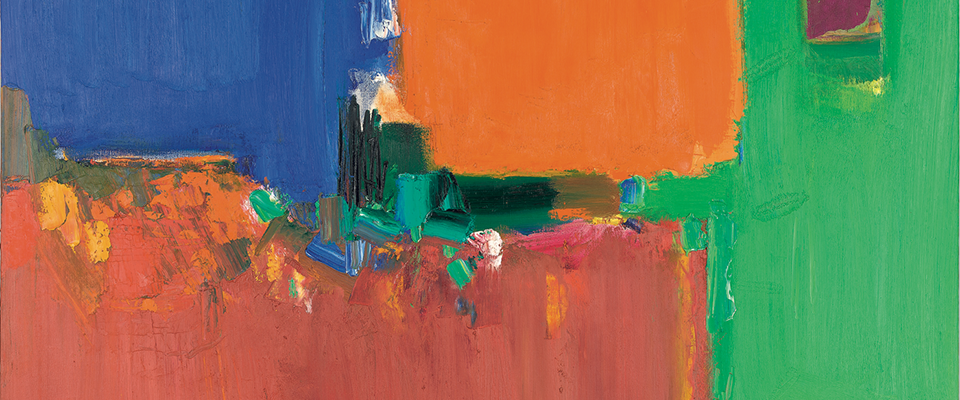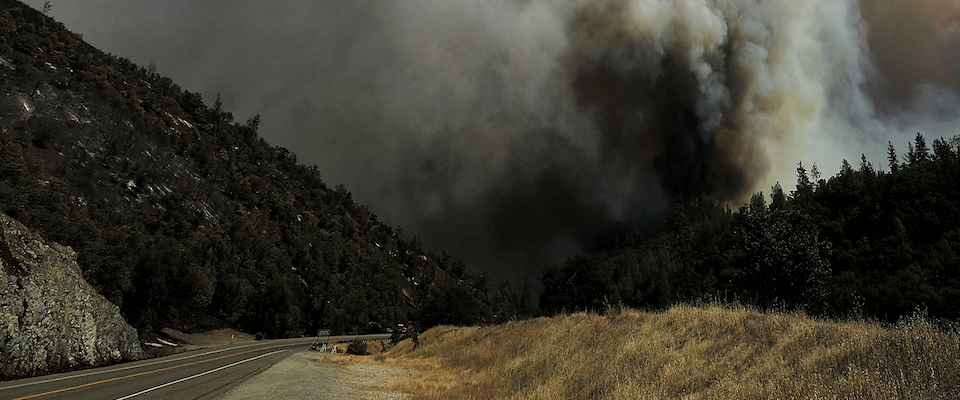Abstract painter Hans Hofmann left his mark on art education at Cal.
Hans Hofmann, the great abstract expressionist painter and teacher, might never have made his indelible imprint on 20th-century American art, first on the West Coast and ultimately across the U.S., had it not been for two summers teaching at UC Berkeley. The invitation came from Worth Ryder, an art department faculty member and former Hofmann student, and without it, it’s possible there wouldn’t even be much of a Berkeley Art Museum.
More than half a century after his death, visitors to the UC Berkeley Art Museum and Pacific Film Archive (BAMPFA) come from all over the world to seek out Hofmann paintings. His audaciously colorful, compositionally vital canvases, some four dozen of them, rank as one of the great magnetic strengths of the collection. Comparably powerful, for the many students who studied with him, was the artist’s influential force as teacher.
Accounts of Hofmann’s instructional methods, along with his own theoretical writings, capture a teacher of formidable assets and a singular approach.
“What Hofmann brought was a spirit of experimentation,” said BAMPFA director and chief curator Lawrence Rinder, “and with it the sense that it was the artist’s responsibility to put themselves into uncomfortable and challenging positions. We take that for granted now. But to people in his classes [at the time], here and elsewhere, … that was revolutionary and exciting.” It made Hofmann “… a shaping force in the Berkeley art department” for decades, that still has resonance today.
Hofmann (1880–1966) was a celebrated 50-year-old artist and teacher when Ryder reconnected with his German mentor. Like many American artists, Ryder had traveled to Europe in the 1920s to study at Hofmann’s famed Schule für moderne Kunst in the Schwabing district of Munich and had never forgotten the experience.
Ryder regarded Hofmann’s school as “the most notable academy of modern art in Central Europe” and he was eager to build the Berkeley art department’s profile—he later became its chairman, and he remained a lifelong Hofmann advocate. And so Ryder asked if Hofmann would be interested in teaching in the 1930 Berkeley summer session.
For Hofmann, who was already sensing the shifting political winds in Germany, the opportunity was timely and irresistible. Nine years later, with the Third Reich in ascendance, his wife, Maria (known as Miz), who had urged her husband to leave Germany, joined him in the U.S. for good. “Thus Berkeley, because of Worth Ryder, became [Hofmann’s] rescuer,” wrote Erle Loran, another of the artist’s former student acolytes. For Loran, Hofmann was nothing less than “the greatest teacher of painting and composition since the Renaissance.”
Accounts of Hofmann’s instructional methods, along with his own theoretical writings, capture a teacher of formidable assets and a singular approach. First there was his deep immersion in European modernism. He had lived and painted in Paris, where he was, by his own account, “in constant touch with Matisse, Picasso, Braque, Delaunay, Derain, Gertrude Stein, and others.” The breakthroughs of cubism, fauvism, color-based abstraction, and surrealism were deeply embedded but never used as proscriptive doctrine in his classes.
“Simplicity should mean pureness, not poorness,” Hofmann said. “Form only exists through color, and color only exists through form.”
Hofmann wanted his students to look closely at other work—from Giotto to Cézanne to their contemporaries—but insisted they learn to create in an unfettered, independent way. Process was more important than a well-schooled finished product. He was known to tear student drawings into pieces on the spot and reassemble them into new compositions.
With his leonine head, Bavarian affability, and a manner of speaking in an accented English “that has not ceased to be German,” as Frederick S. Wright put it, Hofmann was a dramatic presence. He taught “by exploration, by diagrams and sketches, by furious demonstrations, and, like a Zen guru, by shock,” wrote William Seitz in the catalog of a 1963 Hofmann exhibition at the New York Museum of Modern Art.
“He taught principles rather than technique,” said Lucinda Barnes, curator of the Hofmann “Nature of Abstraction” show now at BAMPFA. “He inspired young artists … to look at another work to find their own voice, their own expressive potential.”
Hofmann repeatedly declined to name favorite or standout students. Painting mattered; personality didn’t. “What I love really in the function of a teacher,” he said, “ is the steady contact with new possibilities in the future—with new generations.”
Hofmann’s prose, some of which was translated by Glenn Wessels, yet another Berkeley teacher and artist who had studied with him in Munich, had an incisive clarity. “Simplicity should mean pureness, not poorness,” Hofmann said. “Form only exists through color, and color only exists through form.” An artist must make a “spiritual” connection with both nature and his materials, he maintained, to “translate his inner world.” These and other thoughts, including his oft-referenced ideas about the “push and pull” of picture planes and an activated space within, appear in Hofmann’s invaluable book Search for the Real.
Process was more important than a well-schooled finished product. He was known to tear student drawings into pieces on the spot and reassemble them into new compositions.
Hofmann, who taught steadily in Europe and America from 1915 to 1958, sacrificed some of his own time for painting to his students. But he never stopped sketching. Among his subjects, in the two summers he spent in Berkeley (1930 and ’31), were the oil derricks in nearby Richmond. The fluid, flowing lines of ink invoke the black substance being extracted from the soil.
Another of his Berkeley students, John Haley, recalled Hofmann driving around in a Packard and abruptly stopping in the middle of the street when something caught his eye. A number of his California sketches feature the Packard’s steering wheel in the foreground: Hofmann was inviting the viewer to see exactly what he saw and how he saw it. And so they did, in exhibitions of Hofmann drawings on the Berkeley campus and at the California Palace of the Legion of Honor in San Francisco.
Years after first gaining entry to this country via Berkeley, Hofmann created his own strongest work in America, in an astonishing late-career blossoming. Numerous fine examples are included in “Hans Hofmann: The Nature of Abstraction,” a major exhibition curated by BAMPFA curator emerita Barnes and on view through July 21, 2019.
After his two seasons of teaching in Berkeley, the artist decamped to the Chouinard School of Art in Los Angeles before establishing the Hofmann School of Art in New York, with summer classes held in the burgeoning Provincetown arts community on Cape Cod. In the process he influenced a generation of such important artists as Helen Frankenthaler, Larry Rivers, Lee Krasner, Allan Kaprow, and Joan Mitchell. His wide and enduring impact, in Berkeley and far beyond, can hardly be overstated.
If Hofmann had left California behind, he never forgot the welcome Berkeley had shown him. In 1960, the artist donated his ebullient painting Summer Bliss to the University in honor of his old patron, Worth Ryder, who had recently died. Lawrence Rinder is not alone in speculating that the subject and title may have been a gesture of gratitude for that first happy summer Hofmann had spent in Berkeley 30 years before.

A more substantial gift came three years later, in 1963, when Hofmann arranged to donate dozens more paintings to Berkeley—47 in all—over a five-year period. The initial selections were made by the artist in consort with Erle Loran. Through sales of other work, Hofmann raised $250,000, an enormous sum at the time, to support a new Berkeley Art Museum that was in the works, as well as scholarships for art students. Clark Kerr, UC president at the time, was an enthusiastic participant in the negotiations.
Hofmann died in 1966, two years before the five-year gift was complete. But it went forward as planned, creating a core asset for the striking new building on Bancroft Way, with its muscular Brutalist profile and cantilevered gallery spaces. The Mario Ciampi–designed museum opened in 1970 and (having been found seismically unsound) closed in 2014, in advance of BAMPFA’s move to its current home on Center Street.
Under terms of the bequest, the majority of this gift of Hofmann paintings remained on view at the museum on Bancroft for 25 years. Many were shown in various ways after that, as they still are in the new building. Thanks to the open, connected designs of both the old and current structures, it has always seemed that a Hofmann is in sight.
Under the leadership of Peter Selz, founding director of the Berkeley Art Museum, the Hofmanns catalyzed the growth and importance of the collection. Acquisitions of abstract works by Frankenthaler, Mark Rothko, Sam Francis, Clyfford Still, and Jackson Pollock were at once logical and dramatic moves. “So much of the collection from mid-[20th] century is built around Hofmann,” said Barnes, who first joined the staff in 2000. He is an essential part of the museum, both as a “location and a place from which to teach and welcome the public.”
The bond was mutual. “If I had not been rescued by America,” Hofmann said in 1944, of his life here that began in Berkeley, “I would have lost my chance as a painter.”
Hofmannn didn’t lose that chance, either as an artist or as one of the great art teachers of his generation. Because of it, the BAMPFA and its patrons, not to mention art lovers across the country and the world, can go on counting their own enduring good fortune.
Steven Winn is a San Francisco freelance writer and critic whose work appears in the San Francisco Chronicle, San Francisco Classical Voice, and elsewhere. He conducts interviews for City Arts & Lectures.
From the Spring 2019 issue of California.





















